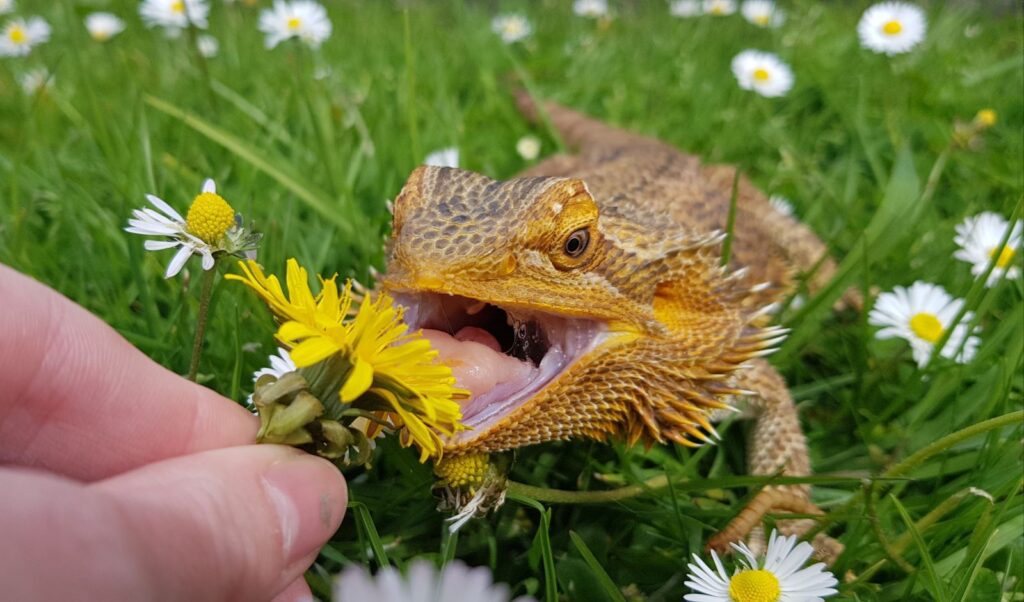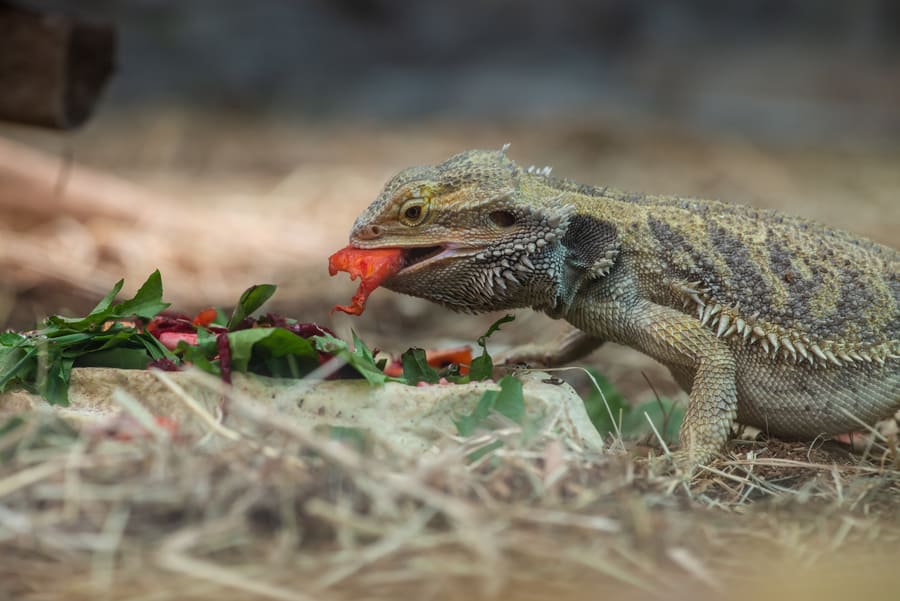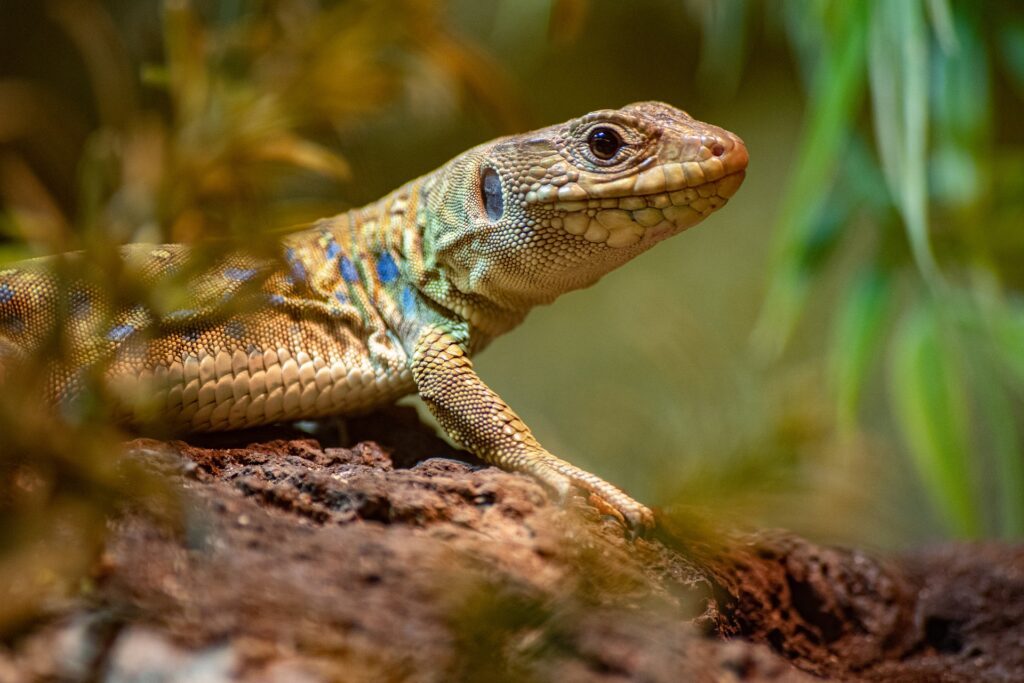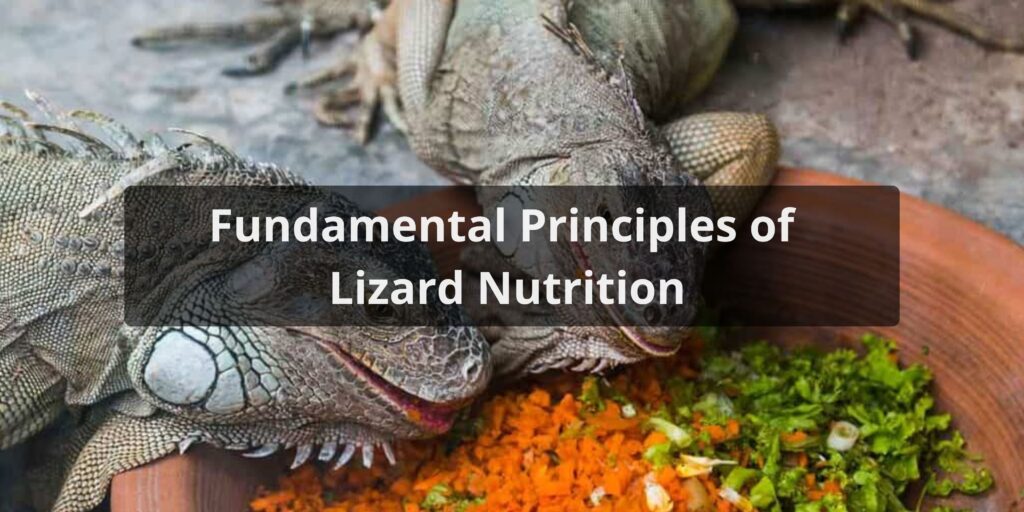Proper nutrition is essential for keeping pet lizards healthy and thriving. There are some fundamental principles of lizard nutrition that every owner should understand in order to meet their pet’s dietary needs. In this article, we will go over the key elements of a complete and balanced lizard diet, basic feeding requirements, and tips for optimal lizard nutrition.
Four Fundamental Principles of Lizards Nutrition
Lizards are a diverse group of reptiles that come in various sizes, shapes, and colors. They have specific nutritional requirements that must be met to maintain their health and well-being. The fundamental principles of lizard nutrition revolve around providing a balanced and varied diet that meets their specific needs.
Balance
Balance refers to providing your lizard with a balanced diet that contains the right proportions of macronutrients such as protein, fat, and carbohydrates.
A balanced diet will also include a sufficient amount of micronutrients like vitamins and minerals that are essential for the proper functioning of various bodily systems.
Providing a balanced diet ensures that your lizard has everything it needs to maintain its health and wellbeing. The specific nutrients that a lizard needs will vary depending on its species, age, and activity level.

When feeding cultured insects, such as mealworms and crickets, it is important to consider the diets on which these insects are maintained. Mealworms are usually kept on nutrient-poor substrates (such as wheat bran), while crickets and woodies are often transported and sold without any meaningful nutrition other than a piece of carrot for moisture.
Often, insects are “gut-loaded” just prior to being fed out. This means that they are fed a high-nutrient diet for a short period of time before being harvested. However, the effectiveness of gut-loading is questionable, as the gut-fill volume of insects is very small.
Variety
Even if your lizard is an insectivore, it is still important to provide it with a variety of insects to eat. This involves providing your lizard with a wide range of food options to ensure that they receive a diverse array of nutrients.
In particular, the emphasis should be on providing as much natural food as possible. Different types of vegetables, fruits, insects, and other foods can provide a variety of nutrients that your lizard needs to thrive.
A varied diet also helps to prevent boredom and ensures that your lizard is getting the full spectrum of nutrients necessary for optimal health. This will help to ensure that your lizard is getting all of the nutrients it needs. Rotate different produce items and insect types to prevent boredom. Vary colors too.
Insectivorous species, in particular, should be provided with natural food beyond commercially available mealworms, crickets, and woodies. A wider range of invertebrates that can be easily harvested from the garden or around the home, such as termites, slaters, snails, spiders, earthworms, and moths, can be used. Moth traps can attract a large variety of flying insects that can be stored frozen for extended periods.
For carnivorous species, offering a variety of food can go beyond the standard fare of commercially produced mice or rats. Birds such as frozen quail, squab, or day-old chicks can also be taken by many species.
Moderation
Moderation in feeding your lizard means feeding them the right amount of food for their size and activity level. This will help to ensure that they are getting the nutrients they need without overeating or undereating.
Overfeeding can lead to obesity and potentially serious health issues, such as heart disease, liver disease, and kidney disease. It can also shorten your lizard’s lifespan.
Underfeeding can result in malnutrition and nutritional deficiencies. This can lead to a variety of health problems, such as weight loss, muscle weakness, and stunted growth.
To determine the correct amount of food to feed your lizard, you should consult with a veterinarian or experienced reptile keeper. They can help you create a feeding plan that is tailored to your lizard’s individual needs.
Gut Loading and Dusting
For insectivorous lizards, “gut loading” the insects with a nutritious diet before feeding and “dusting” them with a vitamin and mineral supplement can provide additional nutrients. This is especially important for those kept in captivity where a natural diet is hard to replicate.
Gut loading is the process of feeding the insects a nutritious diet before feeding them to the lizard. This ensures that the lizard gets the nutrients it needs from the insects, even though the insects themselves may not be naturally high in nutrients.
The best foods to use for gut loading insects include: Dark, leafy greens; Fruits; Squash; Grains; Tropical fish flakes; Cat food; Prepared reptile foods; Bee pollen.
The insects should be gut loaded for at least 24 hours before being fed to the lizard. This gives them time to digest the food and absorb the nutrients.
Dusting is the process of sprinkling insects with a vitamin and mineral supplement before feeding them to the lizard. This helps to ensure that the lizard gets the essential vitamins and minerals it needs, even if the insects are not gut loaded.
The best supplements to use for dusting insects include: Calcium carbonate; Vitamin D3; Vitamin A; Multivitamin.
The insects should be dusted every time they are fed.
Gut loading and dusting are especially important for insectivorous lizards that are kept in captivity. This is because it can be difficult to replicate the natural diet of these lizards in captivity. By gut loading and dusting the insects, you can help to ensure that your lizard gets the nutrients it needs to stay healthy.
Fundamental Principles of Lizards Nutrition – Gut Loading and Dusting

Elements for a Complete and Balanced Lizard Diet
Lizards are omnivores, meaning they need to eat both plant and animal matter. Here are the basic nutritional elements a lizard’s diet should contain:
Protein
Amino acids are the building blocks of protein. They are essential for growth and development, as well as for the repair and maintenance of tissues.
Lack of essential amino acids can result in poor growth in juveniles and failed reproduction in adults. Studies on chickens have shown that arginine and methionine are the limiting amino acids when feeding crickets. In captive diets, essential amino acids can be supplemented by including quality animal proteins such as lean meat, fish, eggs or whey protein.
Lizards, such as Bearded Dragons and Blue-tongue Skinks, require a largely insectivorous diet when young to meet their increased protein demands for growth.
The quantity and quality of protein in the diet needs to be carefully controlled to cater for the type and life stage of the reptile in question. Too much protein can be harmful, as it can lead to kidney problems, gout, and pyramiding of the carapace in turtles. However, other factors such as dehydration and disease may also be contributing factors to these problems. Here are some additional points to consider:
- The type of protein that is fed is also important. For example, plant proteins are not as complete as animal proteins, as they may not contain all of the essential amino acids.
- The digestibility of the protein is also important. Some proteins are more digestible than others.
- The age of the reptile is also a factor to consider. Juvenile reptiles need more protein than adults.
It is important to consult with a veterinarian or reptile expert to determine the best diet for your pet Lizards.
Fatty Requirements
Fatty acids are essential components of a lizard’s diet but should be given in moderation. They provide a concentrated source of energy and are important for cell membrane structure, hormone production, and absorption of fat-soluble vitamins like A, D, E, and K.
The primary essential fatty acid (EFA) for reptiles, including lizards, is linoleic acid. Some veterinarians recommend that lizards should have around 0.2% linoleic acid in their diet to avoid health issues. Other fatty acids like arachidonic acid can also be important but usually can be synthesized from linoleic acid by the animal.
The requirements for fats may vary depending on the life stage of the lizard. For example, juvenile lizards might require more fats for quick energy and growth, while older lizards might require less due to decreased activity levels.
Lizards storing insufficient fat usually have tails that are narrower than the width of their body. Conversely, excessive fat can lead to obesity, causing health issues like fatty liver disease. Some species of lizards store extra fat in their tails, and this can be a good indicator of their overall health.
Live insects like crickets and mealworms, often a staple in many lizards’ diets, contain fatty acids. However, these should be gut-loaded or dusted with a supplement to ensure they meet the lizard’s nutritional needs. For herbivorous lizards, certain plant materials can also provide necessary fatty acids.
Lizard Calcium, Vitamin D and Mineral Levels
Many captive lizards suffer from mineral deficiencies. For example, feeding a lizard a diet high in meat protein without anything else results in low calcium levels. This is also true in lizards that primarily eat insects, since the insect skeleton does not retain calcium. For this reason, pet stores recommend that insects such as crickets be gut loaded (insects fed right before feeding to lizard), and that they should be powdered with calcium.
Because of this a vitamin/mineral supplement such as Exo is added to the diet. Lizard health depends on the right balance of calcium vitamin D and phosphorus.
Lizards and Vitamin D: All lizards require Vitamin D in order to metabolize any ingested calcium. Vitamin D is naturally manufactured by the lizard’s body when exposed to ultraviolet light or unfiltered (not through glass or plexiglass) natural sun. The method at which your lizard gets vitamin D varies by diet and natural or ultraviolet light exposure along these general guidelines:
- Lizards that Each Whole Mice or Other Animals: Usually receive enough vitamin D from the diet and do not require a supplement
- Insectovorous Lizards: Gut loaded insects (just fed) and powdering of Calcium/Vitamin D supplement on food/insects
- Herbevorous (plant eating) lizards with limited UVB (ultra violet light) exposure: Provide vitamin D/Calcium supplements
Note that it is important not to overdose vitamin D or calcium. Too much vitamin D, calcium or phosphorus can results to hormonal imbalance resulting in the levels of calcium, phosphorus or magnesium become elevated. Conversely, not getting enough will also result in hormonal problems. The result will be weakened lizard bones, particularly in the jaw (bone softening called osteomalacia). Other problems that could result include kidney stones, rickets and broken bones. Symptoms of a mineral overdose in lizards includes seizures and muscle contractions that do not return to the normal state.
A typical recommendation for herbivores is to receive a mineral supplement such as Rep-cal phosphorous free calcium supplement provided 3x per week.
If you see any of these symptoms, are suspect that the lizard food and supplements is not meeting the mineral requirements of your species, consult with a veterinarian either in person, or by using an online veterinary service like this one. Other lizard disease related symptoms are a lack of appetite, and when they stay in the warm areas in the habitat or aquarium.

Water
Providing the right type of water is crucial for the well-being of pet lizards. It’s generally recommended to use bottled spring water rather than tap water for reptiles and amphibians, as it is consistent in quality and does not require treatment for chlorine or chloramines. Always ensure that the water is fresh and clean, and replace it at least once every 24 hours, or more frequently if the reptile has defecated in the water dish. The water dish should be shallow to prevent drowning risks.
Different types of lizards have unique methods for water intake. Some species absorb water through their skin, while others may drink from droplets on plant leaves or the sides of the enclosure. This makes it vital to know the specific hydration needs and methods of your pet lizard species. Always consult with a qualified veterinarian for specific recommendations tailored to your pet.
Water also plays a role in maintaining humidity levels within the lizard’s habitat, especially for species that require higher humidity. Misting the enclosure with water can help in maintaining the correct humidity levels. Be cautious to not make the environment too damp, as that can lead to other health problems like fungal infections.
It’s also crucial to clean water dishes regularly to prevent the growth of harmful bacteria and other microorganisms. Juvenile lizards are particularly susceptible to issues that can arise from poor water quality. Automated water fountains specifically designed for reptiles are also available, providing a constant flow of clean water, but these too must be cleaned regularly to ensure they remain a safe source of hydration.
Some wild lizards get their water primarily from their diet. For example, insectivorous lizards may consume a large amount of water through their prey. Herbivorous lizards have evolved mechanisms like salt glands to deal with water regulation.
Dehydration can quickly become dangerous for lizards. Always provide fresh, clean water in a shallow dish that is cleaned and refilled daily. Some lizards gain moisture from food, but additional water should still be offered. Misting the enclosure can also boost humidity.
Principles of Lizard Nutrition BY Life-stage
Lizard nutrition is not a one-size-fits-all scenario; it varies significantly based on the life stage of the reptile.
- Hatchlings and juveniles: Young lizards often require more frequent feeding schedules and a diet that is rich in protein to facilitate growth and development. Some juvenile lizards may require daily feeding and will often benefit from additional calcium and vitamin D3 supplements to aid in bone formation.
- Adult Lizards: Adult lizards still need a diet that is high in protein, but they do not need as much calcium as hatchlings and juveniles. Adult lizards generally require less frequent feeding, perhaps every other day or even less often for some species. A balanced diet still rich in essential nutrients but lower in protein can be suitable for adults. Some adult lizards may also benefit from seasonal variations in diet, mimicking their natural feeding patterns in the wild.
- Mating or Breeding Females: Lizards that are mating or pregnant will need a diet that is higher in calories and nutrients. This is because they are expending more energy and their bodies are demanding more nutrients to support the development of eggs or young. Good choices for breeding lizards include insects, small mammals, and fruits and vegetables that are high in calcium and vitamin A. If you’re dealing with a gravid or lactating female lizard, her nutritional requirements will differ from other life stages. Such females often require additional calcium and other nutrients to support egg development or lactation.
- Senior Lizards: Older lizards may require special considerations regarding their diet. Lower metabolism means they may need less food overall, and attention should be paid to the balance of nutrients to avoid obesity and other health issues.
- Adjustments for Season and Environment: Some lizards, especially those in captivity, may require adjustments to their diet based on seasonal changes. For instance, reduced light and colder temperatures in winter may necessitate a decrease in food intake. Some lizards hibernate during the winter months. During this time, they do not eat and their metabolism slows down. However, they still need to get some nutrients to stay healthy. A good way to do this is to provide them with a food source that is high in fat, such as mealworms or waxworms.
Principles of Lizard Nutrition by Lizard Type
While all lizards require the nutritional elements listed above, different types of lizards have varying dietary requirements, and it’s essential to understand these needs when caring for a pet lizard.
- Insectivorous lizards like bearded dragons diet need 50-60% protein from live feeder insects with the remaining 40-50% from leafy greens and veggies.
- Herbivorous lizards such as iguanas need 70-80% plant matter with about 20-30% insects for protein.
- Omnivorous species like blue-tongued skinks do well with an even 50/50 split between insects and produce.
- Carnivorous lizards including monitors tend to requirewhole prey items like mice along with some organ meat and egg.
Factor in your specific lizard species, age, and activity level when planning feedings. An adult crested gecko can thrive on 2-3 feedings per week while a baby leopard gecko diet may need tiny insect meals daily.
Tips for Optimal Lizard Nutrition
Follow these tips for keeping your lizard healthy through proper nutrition:
- Protein Sources: Lizards that are insectivores or omnivores need a good source of protein. Consider gut-loading insects like crickets before feeding them to your lizard. This enhances the nutritional value of the meal. Always be sure the insect prey is the appropriate size for your lizard.
- Know your lizard’s diet: The first step in providing optimal nutrition for your lizard is to know what lizards eat in their natural habitat. Different species of lizards have varying dietary requirements, so it is important to research your lizard’s specific dietary needs. Some lizards are herbivores, meaning they eat only plants, while others are omnivores or carnivores, meaning they require a mix of plant and animal-based foods.
- Calcium to Phosphorus Ratio: For bone health, the calcium to phosphorus ratio in the diet should be optimal. Feeding diets with a positive calcium to phosphorus ratio, like collard greens, can help ensure that lizards consume enough calcium for proper growth and bone health.
- Supplement the diet with vitamins and minerals. Even if you are feeding your lizard a varied diet, it is still a good idea to supplement it with vitamins and minerals. This will help to ensure that your lizard is getting all of the nutrients it needs to stay healthy. Lightly coat insects with calcium + D3 powder right before feeding.
- Provide fresh, clean water at all times. Lizards need access to fresh, clean water at all times. Make sure to change the water daily and to clean the water bowl regularly. Place food and water dishes in different spots to encourage natural grazing.
- Avoid feeding your lizard unhealthy foods. Some foods that are safe for humans to eat can be harmful to lizards. For example, avocados, chocolate, and onions are all toxic to lizards. It is important to do your research before feeding your lizard any new food.
- Don’t overfeed: Overfeeding can lead to obesity and health problems in lizards. It is important to feed your lizard an appropriate amount of food based on their size, age, and activity level. A good rule of thumb is to feed prey that is no larger than the space between your lizard’s eyes
- Feed your lizard in a quiet area. Lizards can be easily stressed, so it is important to feed them in a quiet area where they will not be disturbed.
- Do not handle your lizard immediately before or after feeding. Handling your lizard can stress it out, which can make it less likely to eat.
- Watch your lizard’s weight. If your lizard is losing weight, you may need to increase the amount of food you are feeding it.
- Remove uneaten food: To avoid spoilage, take out any produce or insects not eaten within 24 hours.
- Talk to your veterinarian about your lizard’s diet. Your veterinarian can help you create a diet that is specifically tailored to your lizard’s individual needs
-

- Tips for Optimal Lizard Nutrition
How to Change a Lizard Diet
If you observe your lizard not doing well on a diet, or if you adopt an older lizard (or from another owner), gradually switch over any diet. This is done by mashing the two foods together. Slowly reduce the proportion of the old diet and the quantity of the new diet.
- Consult with a veterinarian. The best way to determine the best diet for your lizard is to consult with a veterinarian who specializes in reptiles. They can help you create a diet that is tailored to your lizard’s individual needs.
- Gradually switch the diet. Do not change your lizard’s diet abruptly, as this can cause digestive upset. Instead, gradually switch over the diet over a period of 2-4 weeks.
- Mash the two foods together. To start, mash the old food and the new food together. This will help your lizard get used to the taste of the new food.
- Slowly reduce the proportion of the old diet. As your lizard gets used to the new food, you can start to reduce the proportion of the old diet. Gradually increase the proportion of the new diet until your lizard is fully transitioned to the new diet.
- Be patient. It may take some time for your lizard to adjust to the new diet. Be patient and do not force your lizard to eat the new food.
Conclusion
Proper nutrition is a key component of lizard health and wellbeing. By understanding the basic nutritional requirements of lizards, providing a balanced diet of insects, leafy greens, veggies, and supplements, and tailoring feedings to your specific lizard’s needs, you can ensure your pet receives the right nourishment. Adhering to fundamental principles of lizard nutrition will go a long way in keeping your scaly companion content. With a little effort and planning, you can become a nutrition expert for your beloved lizard!
FAQs
What vitamins and minerals are essential for lizard health?
Lizards require essential vitamins like A, D, and calcium, as well as minerals like phosphorus. These nutrients are vital for bone health, metabolic functions, and overall well-being. Proper supplementation and access to UVB light, which aids in vitamin synthesis, are crucial for lizard health.
How do I ensure that my lizard’s diet is balanced and nutritious?
A balanced lizard diet includes a variety of insects, greens, and fruits appropriate for the species. Research your lizard’s specific dietary needs, monitor portion sizes, and provide supplements when necessary. Consult with a reptile veterinarian or expert to create a nutritionally complete diet plan.
Can I feed my lizard insects I catch in my backyard?
Feeding wild-caught insects to your lizard can be risky. Wild insects may carry parasites or pesticides that can harm your pet. It’s safer to purchase insects from a reputable source, ensuring they’re free from contaminants and suitable for your lizard’s consumption.
Are there common mistakes to avoid when feeding pet lizards?
Common mistakes include feeding an imbalanced diet, overfeeding, and not providing access to UVB light. Neglecting dietary variety or proper supplementation can lead to nutritional deficiencies. Monitoring portion sizes is essential to prevent obesity. UVB light is crucial for calcium metabolism.
What are the signs of nutritional deficiencies in lizards?
Signs of nutritional deficiencies may include lethargy, weakness, bone deformities, soft shells (in turtles and tortoises), and difficulty shedding. Calcium deficiency can lead to metabolic bone disease. Regular veterinary check-ups can help detect and address nutritional issues before they become severe health problems.



